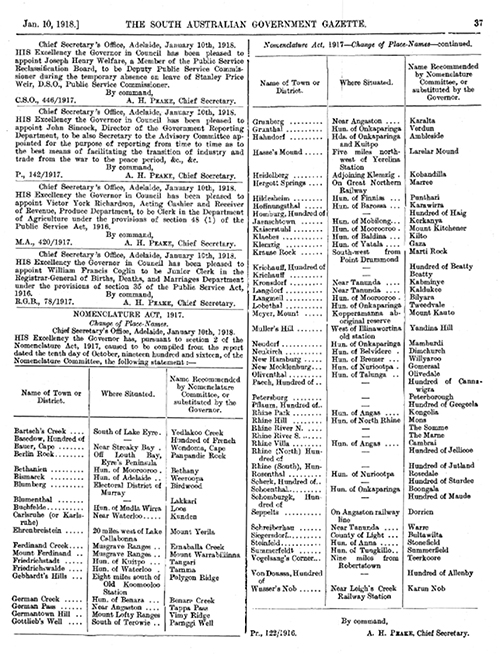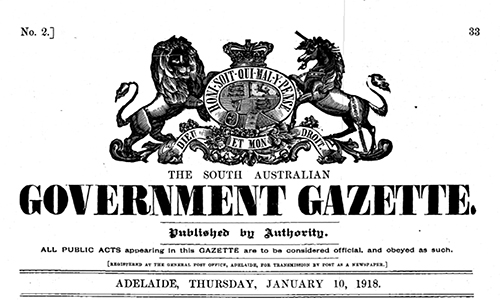![Farmhouse on Bismark Hill [B 70683/7]](/sites/default/files/styles/hero_large_1x/public/2018-05/FarmhouseBismarkHill-B-70683-7.jpg?itok=F-KVQ7_E)
A place by any other name: From Bismarck to Weeroopa to Brooklyn Park
In South Australia, in the midst of World War One, many places were renamed. But which ones? The South Australian Government Gazette holds the answer, and thanks to the digitisation of this valuable resource, the list can be accessed, and read with the newspapers in Trove and the State Gazetteer to tell an amazing story.
The Otto von Bismarck Foundation contacted the Library about some photographs in our collection - Bismark Gully Farm [B 70683/9] and Farmhouse on Bismark Hill [B 70683/7]. The Foundation was marking a Google Map with places associated with the first chancellor of the German Empire.
Image caption: Farmhouse on Bismark Hill [B 70683/7]
Place name information stored in our State Gazetteer showed that the photographs refer to Bismark Valley, the name of a gully and also a homestead, North of Balakava, SA. The search also turned up Bismarck, the Adelaide suburb. Bismarck, Adelaide?
In the First World War, as newspapers filled with stories of South Australian wounded, missing and killed, sentiment turned against everything of German origin. As a result, our House of Assembly passed a resolution on August 2nd, 1916:
That, in the opinion of this House, the time has now arrived when the names of all towns and districts in South Australia which indicate a foreign enemy origin should be altered, and that such places should be designated by names either of British origin or South Australian native origin.
A Nomenclature Committee given the task of scouring the State Gazetteer for German names found 67 cases worthy of change. Aboriginal names, in line with what they termed "popular desire that favours the preservation of aboriginal patronymics", were recommended as the new names. Their report was printed as Parliamentary Paper no. 66 in 1916, and was widely debated.
Between making their report and the new names being officially adopted in 1918, most Aboriginal names recommended were dropped by Parliament in favour of names commemorating the War. Sites such as Loos, Vimy Ridge, Mons, The Somme, The Marne, Cambrai, and Gaza, along with the generals Kitchener, Haig and Ambleside, were joined by simple anglicising like Stonefield for Steinfeld, and Peterborough for Petersburg, in a general rejection of the Committee's recommendation of Aboriginal names.
The transition was not smooth in all quarters, and the local council received a petition with 99 signatures protesting the change from New Hamburg (near Strathalbyn) to Willyaroo. Also, the Committee recommended Lobethal be changed to Marananga, but a local campaign against this resulted in the adoption of the name Tweedvale.
The list of changed names was published in the South Australian Government Gazette no. 2, 10 January 1918.
Image caption: The South Australian Government Gazette no. 2, 10 January 1918, p. 37
The first 80 years of the South Australian Government Gazette are available free online thanks to a project started by the SA Branch of the Australian Law Librarians Association. The State Library and law firm Piper Alderman donated Gazettes for scanning. We lent four volumes for non-destructive scanning and donated a further 70 volumes as 'sacrificial' copies for high volume digitising
Image caption: The South Australian Government Gazette no. 2, 10 January 1918, masthead
So what happened to the renamed suburbs and towns? A 1935 Act of Parliament reversed the name changes of the three major sites Gaza, Ambleside and Tweedvale, back to their German names Klemzig, Hahndorf and Lobethal. Just in time for World War Two.
As for the suburb Bismarck, it was deemed an enemy name and changed to Weeroopa in 1918, and then became the now-familiar Brooklyn Park in 1944. The name Bismarck was suggested by the Austrian consul (the land's original vendor), and Weeroopa, Aboriginal for crested parakeet, was suggested by the Committee.
According to the State Gazetteer, the Dohse, Lange, Baum and Zerk families who lived in the valley North of Balaklava had no known affinity with the German Chancellor. By using the name Bismark they said "they were having a joke on themselves". The site of the Bismark homestead is still the centre of a working farm.
*Note there are two different spellings used - Bismarck and Bismark.
Written by: Richard Moriarty, Information Services Support Officer
![Farmhouse on Bismark Hill [B 70683/7]](/sites/default/files/2018-05/FarmhouseBismarkHill-B-70683-7.jpg)

